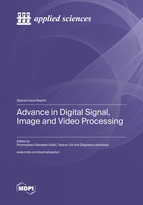Advance in Digital Signal, Image and Video Processing
A special issue of Applied Sciences (ISSN 2076-3417). This special issue belongs to the section "Computing and Artificial Intelligence".
Deadline for manuscript submissions: closed (10 March 2023) | Viewed by 28903
Special Issue Editors
Interests: audio; broadcasting; coding; compression; mobile technologies; multimedia; positioning; signal processing; speech processing; video; wireless communication
Special Issues, Collections and Topics in MDPI journals
Interests: data compression; feature selection; image denoising; image resolution; Internet technologies; IP networks; quality evaluation; video coding; video streaming
Interests: acoustics; GIS; hydroacoustics; multibeam sonar; object reconstruction; remote sensing; seabed classification; satellite communication; signal processing
Special Issue Information
Dear Colleagues,
It is assumed that high performance and quality, especially in the case of signal transmission, will lead to great acceptance and usability. However, with the outbreak of numerous digital systems and services, including audio and video processing, low quality or best effort services have gained enormous popularity. This fact is observed particularly in the case of Internet and mobile technologies, for example, content storing and management, multimedia consumption, and digital maps and images. It is also clearly visible in the growth of the number of users and available applications. Moreover, it shows that the relationship between performance, quality and acceptance is not fully recognized.
The term quality can be understood in many different ways. Engineers perceive the term as quality of service (QoS), which is a synonym for network performance and reliability. However, quality can be defined from a person’s point of view. Quality of experience (QoE), which involves the process of comparing perceptual events with a known reference, is focused on defining the characteristics of media transmission systems or services and their acceptance by customers. As has been observed with the outbreak of desktop and mobile platforms, the number of multimedia services and highly capable consumer devices continues to grow. This forces a broader analysis of numerous practical aspects. This issue aims to describe interdisciplinary advances in digital signal, image, and video processing.
In this Special Issue, we invite the scientific community to publish works highlighting recent advancements in digital signal, image, and video processing.
The topics of interest include but are not limited to:
- Broadcasting and electronic media;
- Coding and compression;
- Content storing and management;
- Geographic information system (GIS);
- Internet technology;
- Image and video signals;
- Mobile technologies;
- Multimedia processing;
- Quality of experience (QoE);
- Quality of service (QoS);
- Speech and music signals;
- Signal processing;
- Streaming services;
- Subjective and objective metrics;
- User experience (UX).
Dr. Przemysław Falkowski-Gilski
Prof. Dr. Tadeus Uhl
Prof. Dr. Zbigniew Łubniewski
Guest Editors
Manuscript Submission Information
Manuscripts should be submitted online at www.mdpi.com by registering and logging in to this website. Once you are registered, click here to go to the submission form. Manuscripts can be submitted until the deadline. All submissions that pass pre-check are peer-reviewed. Accepted papers will be published continuously in the journal (as soon as accepted) and will be listed together on the special issue website. Research articles, review articles as well as short communications are invited. For planned papers, a title and short abstract (about 100 words) can be sent to the Editorial Office for announcement on this website.
Submitted manuscripts should not have been published previously, nor be under consideration for publication elsewhere (except conference proceedings papers). All manuscripts are thoroughly refereed through a single-blind peer-review process. A guide for authors and other relevant information for submission of manuscripts is available on the Instructions for Authors page. Applied Sciences is an international peer-reviewed open access semimonthly journal published by MDPI.
Please visit the Instructions for Authors page before submitting a manuscript. The Article Processing Charge (APC) for publication in this open access journal is 2400 CHF (Swiss Francs). Submitted papers should be well formatted and use good English. Authors may use MDPI's English editing service prior to publication or during author revisions.







